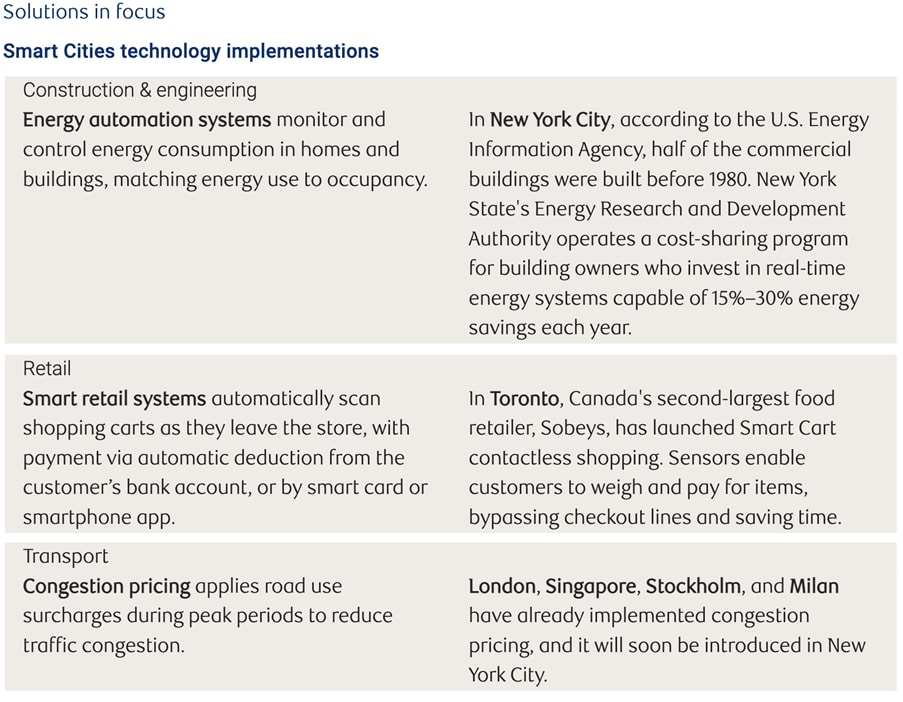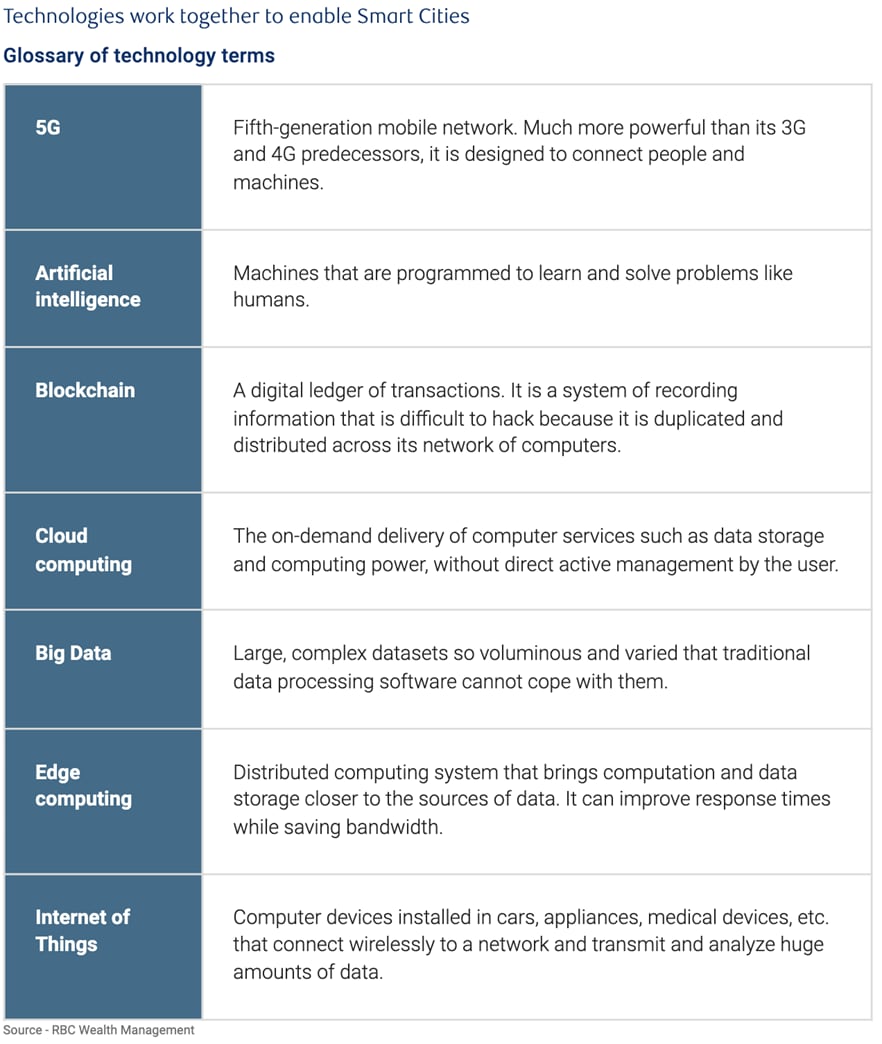In this article, Frédérique Carrier, managing director and head of investment strategy for the British Isles and Asia at RBC Wealth Management, discusses why rising urbanisation is challenging sustainability and infrastructure, and how technology is creating solutions.
With urbanisation rates climbing, and world governments having set ambitious targets to reduce carbon dioxide emissions, pressure is mounting to make cities more efficient while limiting their impact on the environment. Cities account for more than two-thirds of global CO2 emissions. Some have picked up the gauntlet and are using technology to help manage the challenges of urban sustainability. More efficiently run cities can improve productivity, reduce costs, and foster economic growth.
This trend toward smart, sustainable cities is being made possible by the confluence of necessity, government support, and technological innovation. The companies that provide solutions should enjoy tailwinds of secular growth.
Redefining cities with technology
“With a municipal network of 500km of optical fibre, free WiFi routed via street lighting, and sensors to monitor air quality, parking spaces, and even waste bins, Barcelona has been at the cutting edge of testing the internet of things,” trumpets the Financial Times. Barcelona is one of Europe’s Smart Cities.
Smart Cities use technology to improve urban management, making everyday life easier and better for the people that live and work there, while optimising the use of natural resources to minimise their environmental footprint.
More specifically, sensors collect data from across the urban landscape: traffic, transportation systems, air quality, waste management, hospitals, and law enforcement, among others. The data is stored, analysed, and used to respond to challenges in real time.
Smart City solutions span a wide array of uses and services.
They can offer more effective transport networks, better calibrated and less wasteful water supply, just-in-time waste management, efficient lighting and heating of buildings, and safer public spaces. This all may sound futuristic, but many cities we live in already have implemented some smart solutions, such as ride-hailing, municipal water leakage detection, intelligent traffic signals, telemedicine, and emergency response optimisation.
The challenges of increasing urbanisation
Rising urbanization rates, and the many challenges they create, are pushing city planners and authorities to increasingly adopt smart systems. Cities gobble up more than 60% of the world’s energy and generate some 70% of global CO2 emissions. With most governments having pledged to reduce national emissions, lowering the footprint of large cities is key.
Moreover, deteriorating air quality causing health problems, lack of access to fresh water (particularly at times of flooding), overwhelmed waste management, and perennial congestion have long been critical issues and are becoming ever more pressing.
These challenges will only be amplified in the future. Global urbanisation rates are expected to reach 70% by 2050, up from today’s 56.2%, according to the World Economic Forum. India and China alone are expected to take in an additional 300 million and 400 million city dwellers by then, respectively. Urbanisation in North America, already high at 83.6%, is anticipated to inch higher still.


Smart City development: West vs East
Despite having many old cities with legacy infrastructure systems, Europe has long led the way in terms of Smart City projects, with its early adoption of a sustainable, environmentally friendly agenda and focus on public transport and urban infrastructure in general.
A 2018 McKinsey report pointed out how intermodality or combining different modes of public transport in a seamless travel experience, has been a focus of European transport strategy, and how electronic services such as ticketing systems have been driven by rapid technological development. From these, many Smart City applications have evolved.
A feature of Smart Cities in the West is that development is mainly bottom-up, with the private sector and citizens actively engaging in designing projects to improve the quality of life, drive economic growth, and safeguard the environment. For instance, in 2018 the Canadian federal government encouraged some 200 communities across the country to participate in a competition in which quality of life improvements could be leveraged through the use of technology.
The Intelligent Cities program was then created with involvement from Rogers, one of Canada’s predominant cellular and cable providers, and Blue City, a Montreal-based software company that focuses on intelligent road traffic management solutions. Local resident workshops were conducted to pinpoint needs and provide city officials with a roadmap to develop future traffic and public transit infrastructure.
Beyond the input and involvement of city dwellers, there also needs to be a cultural shift in the way cities are governed and operated, as well as for citywide technology platforms to be more open and not housed in “silos” that are unconnected and incapable of collaboration.
When Los Angeles Mayor Eric Garcetti looked into implementing Smart City solutions, he found more than 40 city departments running on various disconnected technology platforms. GeoHub was created in 2016 to assemble more than 500 datasets from the city’s departments, as well as from the county, state, and federal governments, to form a centralized business intelligence system. Shortly after its launch GeoHub was able to unearth insights into Los Angeles’ public safety and infrastructure needs that allowed the city to manage resources and make better decisions.
In Barcelona, several silo-type models used by the city were dissolved: those where networks didn’t communicate, where consumers were tied to inflexible contracts, or where the provision of services was outsourced to large operators with no government oversight of how resident data was collected or used. The responsibility for such data has since been transferred to the government to ensure privacy. Moreover, procurement of services was made transparent with a focus on small local companies.
Meanwhile, Smart City projects have proliferated in recent years in Asia, which is experiencing urbanization and digitization simultaneously. In countries with a strong central government, such as China or Singapore, Smart City development is usually top-down with the authorities formulating policies and providing funding. The focus tends to be on building up infrastructure and improving urban governance capability.
In places where the public sector owns many of the services, Smart Cities are highly developed with services, such as transport, power, telecoms, water, and waste management, all communicating with each other and collaborating. Links to smart buildings—residential, commercial, or industrial—ensure that Smart Cities are fully integrated. This interoperability, the seamless flow of data and technology, is a key requirement of a full-fledged Smart City.
Singapore is a case in point, having been consistently one of the top investors in smart systems, according to the IDC Worldwide Smart Cities Spending Guide. That the city also owns in one way or another public transportation and housing undoubtedly has helped as it reduced the complexity of the task.
China is also well-acquainted with the challenges of urbanisation given it encouraged the rapid migration of rural populations to cities and saw its urban population triple to 900 million in the last three decades. This massive influx amplified already intense social pressures such as urban crowding, mass congestion, strained infrastructure, severe pollution, and a generally high cost of living. China turned to technology to mitigate some of these issues, establishing some 500 Smart Cities.
It may take several years for large legacy Western cities to reach such an advanced stage of Smart City development. It requires abolishing the silo mentality and nurturing collaboration among industries, as well as a willingness of local governments to improve infrastructure with a long-term view, as opposed to quick fixes. But the impetus for improvement is there and we are likely to see the implementation of more smart solutions, both in the East and the West.
How technology enables the Smart City transformation
At the core of Smart Cities is 5G, i.e., the fifth generation of wireless technology. 5G is a leap forward from its predecessor: its speed is up to 10 times faster than 4G; it has low latency, meaning there is only a minuscule delay of 1 to 1,000 milliseconds before a transfer of data begins following an instruction for its transfer; and it allows millions of Internet of Things (IoT) devices and sensors to be connected in a one kilometer square area—4G only allows a limited number of connections.
A number of technologies linked to 5G are needed to achieve advanced Smart City status, such as artificial intelligence (AI), blockchains, cloud computing, Big Data and edge computing, and, of course, the IoT.
For example, a city installs a large number of IoT sensors in order to detect traffic conditions. Once collected, the data are transferred through the 5G network. Blockchain technology can provide secure data transmission during this process. Traffic authorities then leverage edge computing analytics to analyse data in real time, and AI can efficiently sift through large quantities of Big Data to predict traffic flows and find practical solutions to congestion such as diverting traffic or altering traffic light sequences. The dataset is then stored on a secured cloud for future reference and analysis.

The industries helping to create Smart Cities
There are a number of players and aspects involved in bringing Smart Cities into reality:
- 4G, 5G, and WiFi service providers and equipment manufacturers, which cater to the increasing demand for reliable high-speed connectivity; they transmit data collected by sensors through their systems
- Communications infrastructure including the high-capacity telecommunications towers and data centres that facilitate edge computing
- Semiconductor manufacturers that make the sensors to collect data
- Software companies that manage devices and sensors and provide smart solutions
- Cloud storage companies that store the encrypted data
- Cybersecurity companies, which protect systems from hackers and attacks at every step throughout the process of collecting, transferring, processing, analysing, and storing data
- Companies that provide building management systems to maintain and optimize facility operations including energy/water/waste management, reducing energy consumption
- Companies that enable the shift to smart grids and electric vehicles
The challenges to building a Smart City
While the allure of technology might be powerful, there are serious challenges to achieving Smart City status.
Legacy cities have significant hurdles as it is easier to start from a relatively blank slate than to upgrade antiquated infrastructure such as in New York and London. Newer cities in the Middle East and Asia are at a distinct advantage in this regard.
Very large populations are another burden and can make the adoption of some smart solutions more cumbersome. Smaller cities such as Helsinki (1.3 million people) or Zurich (400,000 people) can be more agile in the adoption of new technology. Globally, they ranked second and third, respectively, in the IMD Smart City Index in 2020.
Other challenges that are also major impediments include:
- Lack of interoperability: Bringing various systems together from different sectors to form a cohesive network is difficult, particularly if they are owned by different, at times competing, entities in the private sector
- Data breaches: High interconnectivity can make smart systems vulnerable to cyberattacks
- Mishandling of private data: Smart Cities collect data regarding resident location and lifestyle, so safeguarding privacy is critical; Sidewalk Labs, a subsidiary of Google’s parent Alphabet, had to pull the plug on its plans to build a Smart City on Toronto’s waterfront due to severe criticism from residents fearing “surveillance capitalism”
- Lack of long-term planning: Some cities are not taking into account the maintenance costs of smart solutions, nor are they anticipating how their needs may change over time
One eye on the city of the future
We believe the recent embrace of the green economy by several governments and prospective new public investments in infrastructure in the US and Europe in particular make this an opportune time for cities to invest in their future and for city planners to respond to the ongoing challenges of urbanisation. Large Western legacy cities such as New York and London are under pressure to upgrade their often creaking infrastructure and are moving in that direction.
Smart Cities have the potential to enable us to live and work in a safer, faster, more convenient way. They will require greater interconnection between different forms of infrastructure. Buildings will need to be connected with the grid, and an ecosystem of communicating infrastructure stands to offer more efficient, sustainable, affordable services to citizens.
Yet given the many challenges that remain, in the West, sporadic implementations of smart solutions (rather than the highly developed Smart Cities of the East) are more likely in the foreseeable future. So initially, we’ll probably see Western cities becoming “smarter,” as opposed to becoming outright Smart Cities.
As noted for the other SusTech themes that we’ve delved into this year, we believe the industries and companies that can deliver Smart City solutions will benefit from long-term, secular growth.
This article was written by RBC Capital Management and originally published on the firm’s research and insights page, here.
Disclaimer Past performance is not a reliable indicator of future results.
CMC Markets is an execution-only service provider. The material (whether or not it states any opinions) is for general information purposes only, and does not take into account your personal circumstances or objectives. Nothing in this material is (or should be considered to be) financial, investment or other advice on which reliance should be placed. No opinion given in the material constitutes a recommendation by CMC Markets or the author that any particular investment, security, transaction or investment strategy is suitable for any specific person.
The material has not been prepared in accordance with legal requirements designed to promote the independence of investment research. Although we are not specifically prevented from dealing before providing this material, we do not seek to take advantage of the material prior to its dissemination.
CMC Markets does not endorse or offer opinion on the trading strategies used by the author. Their trading strategies do not guarantee any return and CMC Markets shall not be held responsible for any loss that you may incur, either directly or indirectly, arising from any investment based on any information contained herein.
*Tax treatment depends on individual circumstances and can change or may differ in a jurisdiction other than the UK.
Continue reading for FREE
- Includes free newsletter updates, unsubscribe anytime. Privacy policy





